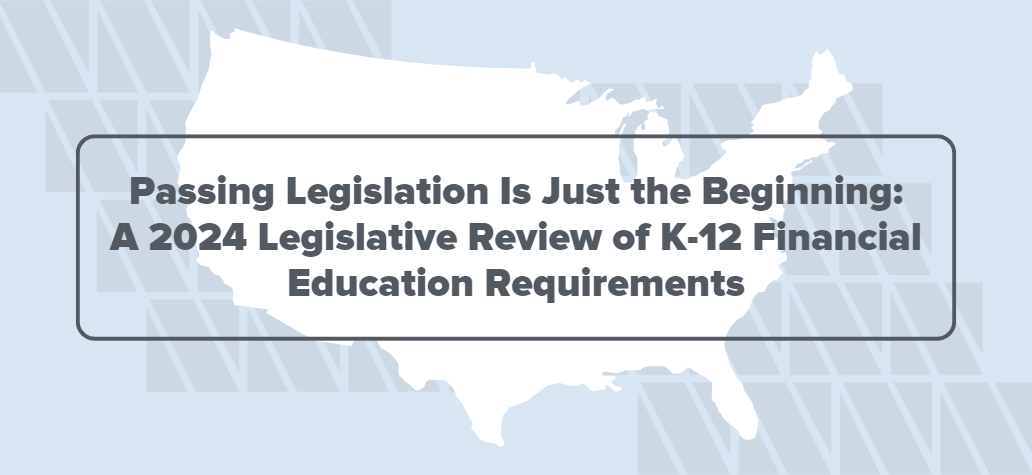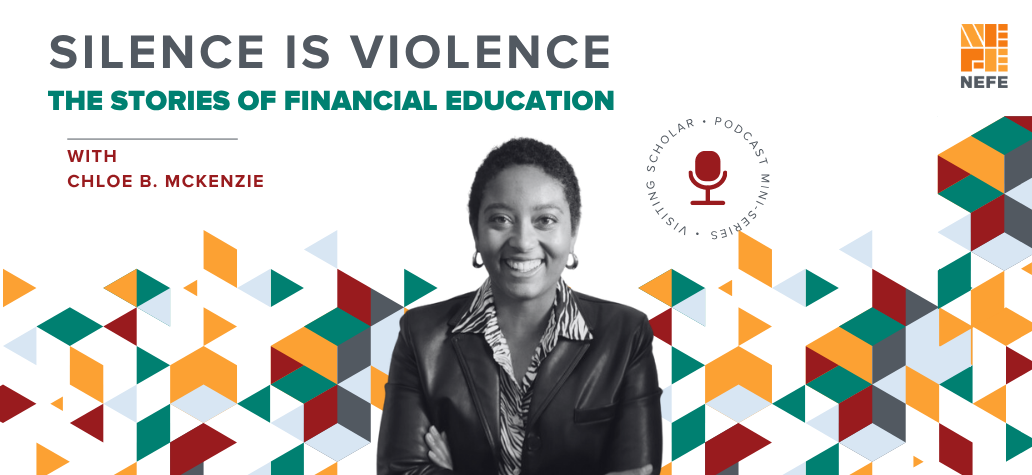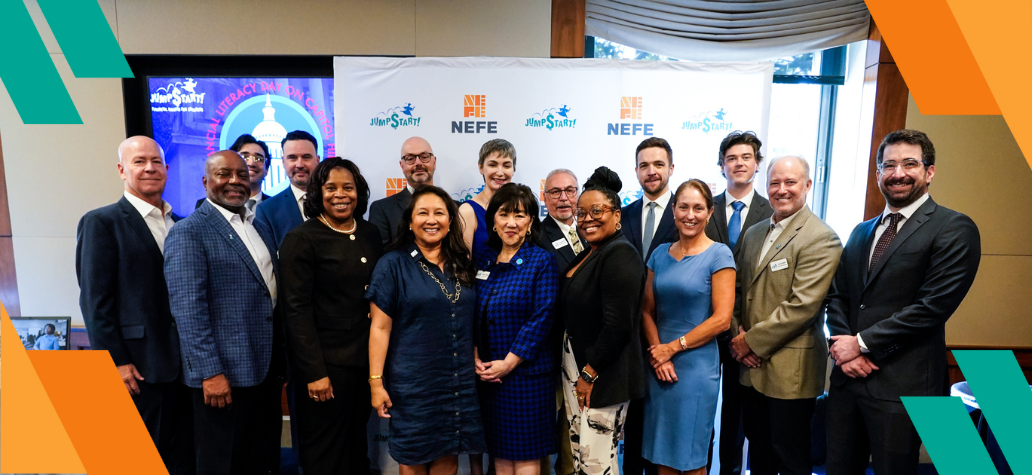During the 2023-2024 legislative sessions across the country, 13 states introduced legislation regarding a financial literacy requirement for high school students. Not all of the legislation was successful, with California as the only state to pass it. New Mexico changed its graduation requirements but failed to include financial literacy. Oklahoma passed a bill that strengthened its financial literacy course requirements but did not include a full graduation requirement. Alaska and Washington introduced legislation for a semester course in financial literacy but neither passed. New York introduced legislation but is taking an alternative path to a requirement. Additional states that introduced legislation that either failed or is still in progress are Delaware, Hawaii, Illinois, Maine, Massachusetts, New Jersey, and Vermont. This review does not examine every state that introduced legislation but offers highlights. Although fewer bills have passed compared to previous years, those states that previously passed requirements are busy with the implementation phase. While most processes have been smooth, Oregon debated several options within the initial proposals but ultimately passed rules adopting a stand-alone requirement. This review analyzes legislative developments, examines the implementation process and details what states should consider when developing a plan.
For the Win: Passed Legislation
For a state to count as having a graduation requirement the state must offer at least a stand-alone semester course in financial literacy and every student must take that course in order to graduate. States may have an integrated course as long as it is a year-long and 50% or more of the coursework hours are devoted to financial literacy.
California

California became the 26 state to require a financial literacy course as a graduation requirement. This requirement will add over 1.9 million California high school students to the more than 5.1 million students in states that also have passed a requirement, and will continue to shift the national conversation. California had two approaches to introducing the requirement—legislatively and through a ballot measure. Assembly Bill 2927 was introduced on February 15, 2024. It passed the Assembly on May 22 and the Senate on June 27 (unanimous in both chambers) and was signed by Governor Gavin Newsom on June 29.
California also was the first state to see a financial literacy ballot measure. The California Require Personal Finance Course for High School Graduation Initiative was filed on September 5, 2023, by Christopher Lee Kaufman and Tim Ranzetta. Californians for Financial Education, supported the initiative, which collected nearly 900,000 signatures, well above the 546,651 needed to qualify for the ballot. This demonstrates strong statewide support for financial literacy. The initiative qualified for the ballot on May 8, 2024.
The ballot measure’s sponsors, legislative leadership and the governor announced an agreement on June 27. The agreement is reflected in the passed legislation, which was sponsored by NGPF Mission 2030. Mission 2030 is a community goal of all high school graduates having access to and completing a financial education course. The sponsors pulled the ballot measure from the November ballot on June 27. The legislation and ballot measure language started almost the same, but amendments altered the legislative version, including moving the full implementation date from the 2029-2030 school year to 2030-2031 and allowing the financial literacy requirement to replace the economics graduation requirement. The final legislation requires, beginning with the 2027-2028 school year, that all schools must offer a stand-alone semester course in personal finance. All students graduating in the 2030-2031 school year and after must take a stand-alone semester personal finance course. Students may also elect to be exempt from the economics requirement in 2030-2031.
The Instructional Quality Commission (IQC) will develop and recommend to the State Board of Education (SBOE) the adoption of a curriculum guide and resources for a stand-alone semester course. The SBOE must adopt these resources before May 31, 2026. $300,000 has been appropriated to the IQC to carry out this work.
New Mexico
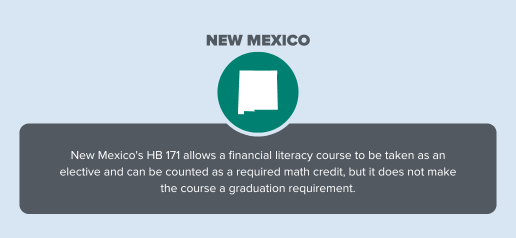
HB 171 changed graduation requirements for students entering ninth grade in the 2025-2026 school year. The bill passed in the House by a vote of 57-1, unanimously in the Senate and was signed by Governor Michelle Lujan Grisham. The legislation does not require a financial literacy course as a graduation requirement, but rather, it can be taken as an elective course, can qualify as a required math credit and is included in the K-12 standards for social science courses. Advocates argued that it should be included as a graduation requirement, but amendments introduced in the Senate Education Committee and on the Senate floor were rejected.
New Mexico had a chance to ensure that every student received financial literacy education but chose not to make it a requirement as HB 171 emphasized flexibility for districts to tailor the new graduation requirements for their unique needs. While research has shown that requiring a financial education course does not impact graduation rates, the decision leaves the onus on individual districts to recognize the importance of financial education and integrate it effectively into their curricula. The state's choice reflects a broader debate on educational autonomy versus standardization, highlighting the ongoing challenge of balancing local control with the need for pervasive essential life skills education.
Oklahoma

In 2007, Oklahoma introduced the Passport to Financial Literacy, a step toward ensuring all students learn financial literacy. The legislation required that financial literacy topics be embedded into coursework in Grades 7-12. During this most recent legislative session, the legislature took another step forward by passing HB 2158 and HB 3278. HB 2158 takes the necessary competencies in the financial literacy passport and requires that they be taught to students in a one-half-unit course. The material can be taught in an embedded, integrated or stand-alone course, but must be provided in Grades 10-12. This is a partial graduation requirement because districts can integrate or embed personal finance instruction in one or more courses, making it difficult to determine if an entire semester’s worth of coursework is being taught to every student. In states with embedded requirements, only 39% of students are in schools where personal finance is required, either in a stand-alone or embedded course. The legislation does allow the option of offering a stand-alone course as an elective. The hope is that school districts will take this opportunity to develop and provide a stand-alone course focused solely on financial literacy. The legislation does allow the option of offering a stand-alone course as an elective. The hope is that school districts will take this opportunity to develop and provide a stand-alone course focused solely on financial literacy.
HB 3278 adds personal finance to the list of math courses that can count towards the math graduation requirement. The legislation expands how personal finance can count towards different graduation requirements.
The Oklahoma State Department of Education is responsible for:
- Developing guidelines and materials to enable schools to offer financial literacy as a stand-alone course.
- Develop materials for schools to embed the curriculum into existing courses.
- Developing professional development for teachers who want to teach it as a stand-alone course or embed it within another course.
- Developing a bridge program for teachers who wish to transition from embedded instruction to a stand-alone course.
Aspects of this legislation promote a stand-alone course and support teachers and schools who want to offer it.
Back to the Drawing Board: Failed Legislation
Alaska
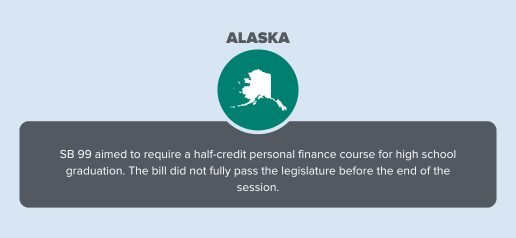
SB 99 was introduced March 9, 2023, and passed unanimously in the Senate on May 13, 2023, but failed due to the session ending on May 15, 2024. The legislation would have required school districts to provide a course that included at least one half-credit hour (equivalent to a semester course) in personal finance and that all students must take the course to graduate. This course could have been a stand-alone semester course or a year-long course that includes a semester’s worth of instruction in financial literacy. Language in the bill stated that the Alaska Department of Education would also have been responsible for curating and making available a list of educational resources for the course.
Washington

Washington is in a unique position. Currently, they do not have a graduation requirement but have the Financial Education Public-Private Partnership (FEPPP), which was allocated millions of dollars from the state legislature in 2022 to provide grants to school districts to support financial education. These grants, available from 2023-2025, set Washington apart as they have substantial funding but no requirement. This contrasts with most states, which have a requirement but very little to no funding to support it.
HB 1915 was introduced on January 8, 2024. It passed in the House unanimously on February 8 and passed in the Senate with a 47-1 vote on February 29. The House version of the bill would have required at least one-half credit in financial education that could be provided either in a stand-alone semester course or integrated into a year-long course. It would have required that every school provide the course starting in the 2027-2028 school year and that all students must take the course starting with the 2031 graduating class.
An amendment passed by the Senate removed the graduation requirement from the legislation. The House refused to accept the Senate amendment as it fundamentally changed the purpose of the legislation, leading to the bill failing on the calendar due to the session ending. The Senate version would have required that all schools provide access to a one-half credit in financial education but would not have required students to take the course.
Some strong aspects of this legislation will hopefully be included in future versions. The legislation would have required that districts report their implementation plans to the SBOE as well as the FEPPP, who would then analyze the plans and create a statewide implementation process to be submitted to the Superintendent of Public Instruction, the SBOE and the state legislature. The plan would include recommendations for additional funding to integrate financial literacy education into professional development and other resources for school districts. Utilizing the FEPPP, which already receives state funding, this legislation directs expertise to support the districts through the implementation process.
Another aspect of this legislation would have required that the SBOE review and monitor the course offerings to ensure compliance and that a summary of this information is provided to the legislature. Directing the SBOE to monitor implementation provides oversight but also offers important information on how the rollout process happens and where additional resources are needed. If Washington passes a requirement in the next session with these policies, they will be in a strong position with thoughtful legislation and funding to support the districts and teachers.
Beyond Legislation: Alternative Approach
New York
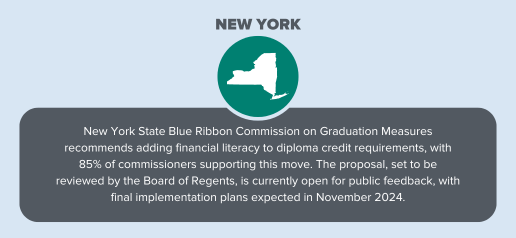
Legislation is not the only way to implement a requirement. While California introduced both legislation and a ballot measure, New York has created a blue ribbon commission that is reviewing graduation requirements as a whole.
The New York Board of Regents created the New York State Blue Ribbon Commission on Graduation Measures in 2019. In November 2023, the commission presented its recommendations to the Board of Regents, which included adding financial literacy to the diploma credit requirements. Eighty-five percent of the commissioners believe that diploma credit requirements must include financial literacy as a high or medium priority, with 72% stating a one-half credit course was a high or medium priority.
In June 2024, the New York State Education Department (NYSED) presented its proposal for implementing the recommendations to the Board of Regents, which included a new financial literacy requirement. The NYSED will host ambassador forums from July to October 2024 to allow the public to share their thoughts on the proposed changes. In November 2024, the NYSED will present its implementation plan to the Board of Regents with a projected timeline, affected regulations and other considerations. The Board of Regents must approve all changes to graduation requirements. An update will be provided once the implementation plan is approved.
Implementation Challenges and Strategies
The SBOE is usually the rule-making authority for graduation requirements. Each state’s department of education is often tasked with interpreting the legislation, holding stakeholder meetings and developing the rules to be approved by the SBOE. The work done by these two groups can determine whether the requirement will benefit all students, if the teachers have resources and support, and if it follows legislative intent.
Oregon Challenges
NEFE’s CEO and President provided testimony during this process. To learn more, read his op-ed here.
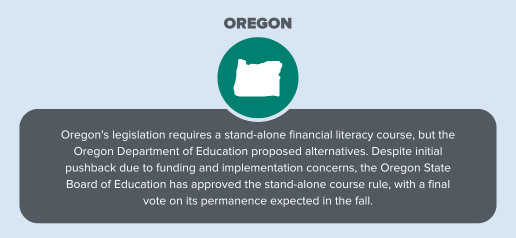
Legislation has become more direct in stating a stand-alone semester course requirement, as seen in California and Oregon. However, the Oregon Department of Education proposed options that did not require a stand-alone course, such as allowing the material to be integrated into other course subjects, disregarding the legislative intent. At a meeting in June, the Oregon SBOE was presented with three options from the Oregon Department of Education and voted on a temporary rule requiring that districts implement the financial literacy requirement as a stand-alone course. The rule includes a provision from the legislation allowing the course to also qualify for another necessary credit, such as math or social studies. This provision was included due to anticipating districts would need flexibility. The vote to make the rule permanent will occur in the fall.
The Oregon Education Association, the Coalition of Oregon School Administrators, the Oregon School Board Association and East Multnomah County Schools submitted a letter to the Oregon SBOE supporting an integrated course. Their main arguments were a lack of flexibility in a stand-alone requirement, the cost of the new stand-alone course and teacher shortages. A member of the SBOE also raised concerns about the lack of funding for this requirement and urged the state legislature to add funding in the next legislative session. This concern over the lack of funding and support for district implementation initially prevented the rule from passing by one vote, but after reconsideration and a request for additional resources, the rule passed. In the implementation process this concern for funding may reappear. School districts can request a one-year waiver for implementing the course but only for staffing-connected concerns. Concerns over funding are a common issue, and not just in Oregon.
Oregon SBOE’s chair ultimately advocated for a stand-alone course after the Oregon Legislative Council stated that the other options violated legislative intent. She pointed out that it would benefit all students and recognized the importance of financial education as a course’s sole focus. Leadership in this process is essential and can determine if the implementation will be successful.
Strategies
Passing a requirement is just the beginning of ensuring every student receives equitable access to a financial literacy course. The details of how it will be implemented, who can teach the course and what type of curriculum will be used are all decided after the legislation is passed. This is typically done through a rule-making process considered and approved by the State’s Board of Education. It is just as important—if not more important—to get the implementation right as it is to pass the legislation. A great deal of attention is paid to the legislative process as the bill is being passed, but often, less attention is paid to implementing the requirement, which can lead to changes that don’t benefit all students.
With so many states having passed requirements in the last couple of years, most are currently in the implementation process. This is an opportunity to embed equity, access and support for teachers within the rules. These aspects are highlighted due to their impact on quality financial education for all students. It is critical to implementation because every student needs to be able to access a course that is relevant to them and taught by a qualified trained teacher.
Access, equity and inclusion are significant needs throughout the implementation process. When states do not require that every student take a financial literacy course to graduate, there are disparities seen in both race and gender.
In states with no requirement, 21.4% of Black and 28.5% of Hispanic students are not offered a course. In states with a requirement, only 10.2% of Black and 13% of Hispanic students are not offered a course.
Hispanic students are the least likely to have access to a stand-alone course, regardless of the state’s requirement.
Research shows that fewer female students choose to take the course when offered but not required. A 2022 study among college students found that 38% of men and 31% of women had chosen to take a financial education course in high school.
States should actively monitor the implementation rollout to ensure that all schools provide the course taught by fully prepared teachers. Requirements must include situational content that engages students, families and the community.
Moving Forward
Several strong pieces of legislation were introduced during this last session that unfortunately did not make it through the process. These states should continue to work on them over the breaks and reintroduce legislation next year to create requirements that support teachers and students. However, legislation is not the only way to create effective requirements; states should consider alternative options, such as working with the State Boards of Education to create the requirements through regulation.
Passing a graduation requirement is only the first step, not the finish line. While requirements go a long way in ensuring access to financial literacy, focusing on quality and impact is just as important, if not more critical, to its success. The resources needed by schools and teachers are all developed in the implementation phase, and if the time is not taken to ensure that these resources benefit every student, then teachers and districts will not have what they need. Rules approved by the State Boards of Education must require a stand-alone semester course or a year-long course that requires a semester’s worth of financial literacy material. States need to provide resources for teachers, including curriculum, guidelines and professional development, to ensure that every teacher is adequately prepared to teach the coursework. Funding is not consistently included in the legislation. In Oregon’s case, SBOE members stressed concern that districts will not be able to successfully implement these requirements. Alternative funding options such as partnerships should also be considered.
Over half of states now have legislation that requires financial literacy for graduation. This is a huge accomplishment for the stakeholders in our field who have worked diligently with decision makers across the country. The work is ongoing. Creating successful policies requires the implementation plan to be carefully thought out and attention paid to ensure that every student receives a strong financial education experience.
Emma Donahue is Senior Manager, Policy and Advocacy for the National Endowment for Financial Education (NEFE), a nonprofit foundation that champions effective financial education. NEFE is the independent, centralizing voice providing leadership, research and collaboration to advance financial well-being.

